If Congress passes the infrastructure compromise reached by the White House and 17 Republican senators, Amtrak will get $66 billion. Amtrak won’t have complete freedom to spend this money however it likes: instead, according to Senator Charles Schumer, $30 billion is for Northeast Corridor backlog and modernization; $16 billion is for other backlog needs; and $12 billion is for new services outside of the Northeast Corridor, “including high speed rail,” as if $12 billion could buy any significant amount of high-speed rail.
Last month, Amtrak revealed that it needs $117 billion to bring the Northeast Corridor up to a state of good repair, so the $30 billion in the infrastructure bill is little more than a down payment. Thus, Congress is continuing its usual pattern of short-funding needed maintenance so that it can fund new projects. After all, if all of the money in the bill went to the Northeast Corridor, senators and representatives in the rest of the country would have little reason to support it.
One of the Northeast Corridor projects funded in the bill is new tunnels under the Hudson River, which are expected to cost $3 billion a mile, more than just about any other tunnels in history. When Slate writer Henry Grabar asked Amtrak CEO William Flynn how he could justify such a high cost, Flynn responded that he didn’t think it was that expensive. Grabar concluded that Amtrak didn’t care about the cost. Continue reading













